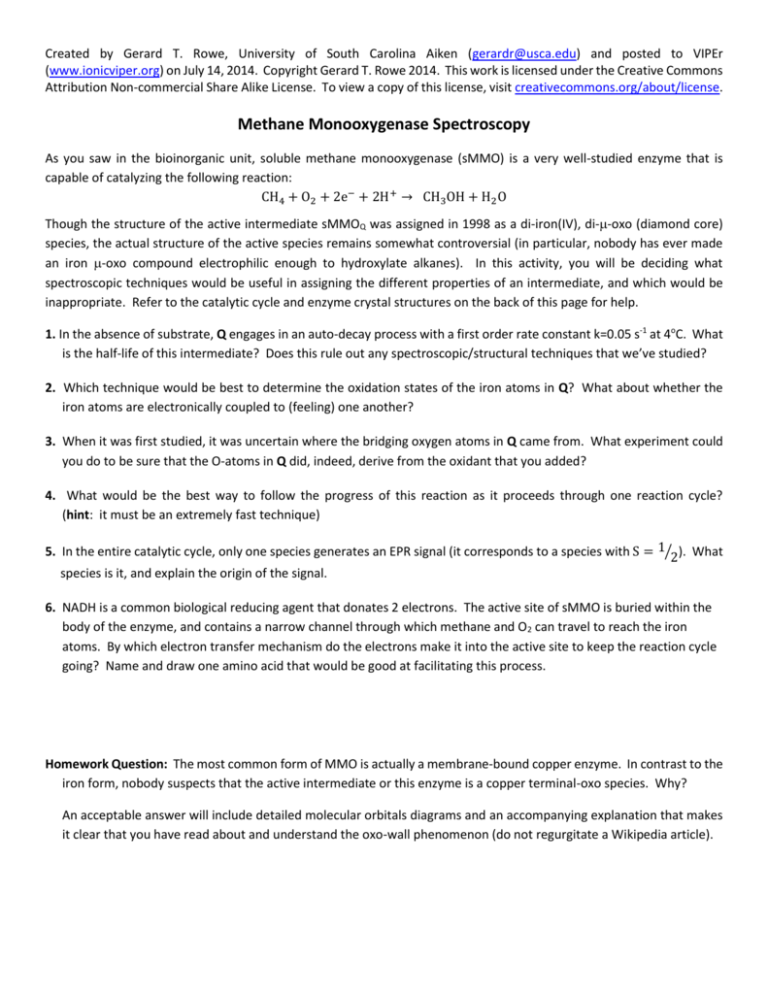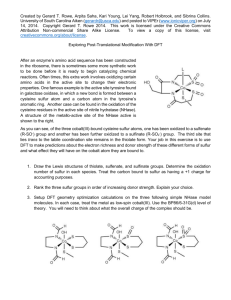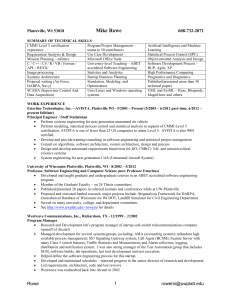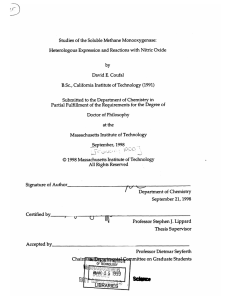Methane Monooxygenase Spectroscopy Activity
advertisement

Created by Gerard T. Rowe, University of South Carolina Aiken (gerardr@usca.edu) and posted to VIPEr (www.ionicviper.org) on July 14, 2014. Copyright Gerard T. Rowe 2014. This work is licensed under the Creative Commons Attribution Non-commercial Share Alike License. To view a copy of this license, visit creativecommons.org/about/license. Methane Monooxygenase Spectroscopy As you saw in the bioinorganic unit, soluble methane monooxygenase (sMMO) is a very well-studied enzyme that is capable of catalyzing the following reaction: CH4 + O2 + 2e− + 2H + → CH3 OH + H2 O Though the structure of the active intermediate sMMOQ was assigned in 1998 as a di-iron(IV), di--oxo (diamond core) species, the actual structure of the active species remains somewhat controversial (in particular, nobody has ever made an iron -oxo compound electrophilic enough to hydroxylate alkanes). In this activity, you will be deciding what spectroscopic techniques would be useful in assigning the different properties of an intermediate, and which would be inappropriate. Refer to the catalytic cycle and enzyme crystal structures on the back of this page for help. 1. In the absence of substrate, Q engages in an auto-decay process with a first order rate constant k=0.05 s-1 at 4oC. What is the half-life of this intermediate? Does this rule out any spectroscopic/structural techniques that we’ve studied? 2. Which technique would be best to determine the oxidation states of the iron atoms in Q? What about whether the iron atoms are electronically coupled to (feeling) one another? 3. When it was first studied, it was uncertain where the bridging oxygen atoms in Q came from. What experiment could you do to be sure that the O-atoms in Q did, indeed, derive from the oxidant that you added? 4. What would be the best way to follow the progress of this reaction as it proceeds through one reaction cycle? (hint: it must be an extremely fast technique) 5. In the entire catalytic cycle, only one species generates an EPR signal (it corresponds to a species with S = 1⁄2). What species is it, and explain the origin of the signal. 6. NADH is a common biological reducing agent that donates 2 electrons. The active site of sMMO is buried within the body of the enzyme, and contains a narrow channel through which methane and O2 can travel to reach the iron atoms. By which electron transfer mechanism do the electrons make it into the active site to keep the reaction cycle going? Name and draw one amino acid that would be good at facilitating this process. Homework Question: The most common form of MMO is actually a membrane-bound copper enzyme. In contrast to the iron form, nobody suspects that the active intermediate or this enzyme is a copper terminal-oxo species. Why? An acceptable answer will include detailed molecular orbitals diagrams and an accompanying explanation that makes it clear that you have read about and understand the oxo-wall phenomenon (do not regurgitate a Wikipedia article). Created by Gerard T. Rowe, University of South Carolina Aiken (gerardr@usca.edu) and posted to VIPEr (www.ionicviper.org) on July 14, 2014. Copyright Gerard T. Rowe 2014. This work is licensed under the Creative Commons Attribution Non-commercial Share Alike License. To view a copy of this license, visit creativecommons.org/about/license. Structures of the reduced (active) and oxidized (resting) forms of sMMO. Notice the shift in ligand environment upon oxidation. The proposed catalytic cycle of sMMO, including the originally assigned structure of Q Adapted from Wallar B. J., Lipscomb, J. D. Chem. Rev., 1996, 96, 2625-2657.









